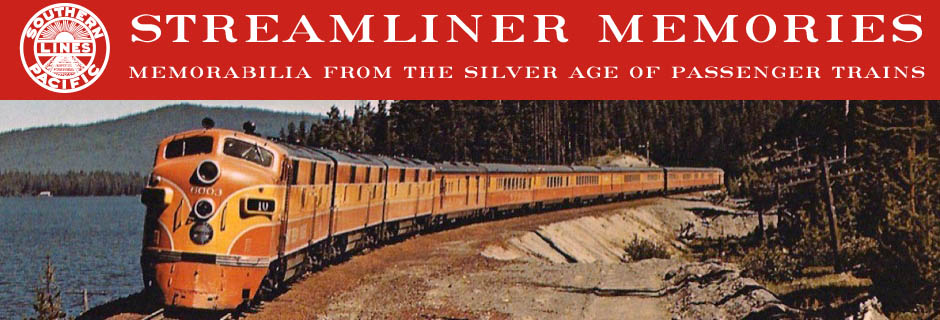Because of the San Francisco and San Diego exhibitions celebrating the opening of the Panama Canal, “California the wonderland, with two Expositions, will be irresistible” in 1915, says this booklet. For easterners who could not resist, the Golden State Limited was the “foremost transcontinental train to California.”
 Click image to download a 27.7-MB PDF of this 28-page booklet.
Click image to download a 27.7-MB PDF of this 28-page booklet.
The booklet is certainly impressive. Oranges on the heavily embossed front cover are not orange but burnished in a special gold ink or paint. The words on the cover and in much of the interior are beautifully calligraphed by an unnamed artist. On the inside front cover, for example, such hand lettering notes that the route of the train has “automatic block signals” and the train uses the “finest modern all-steel equipment,” giving it “absolute safety.”
The all-steel theme is repeated later when the booklet says, “Finest modern all-steel equipment — entire train, including dining car and observation car, through without change between Chicago, Kansas City, and California.” This implies that the entire train is steel, but carefully read it really only says that the entire train goes through without change between Chicago and California.
Equipment diagrams in the back describe the sleeping cars as “all-steel” but do not use the same term for the observation or dining cars. So I suspect that, in 1915, only the sleepers (which were owned by Pullman) were all steel while the non-revenue cars (which were owned by the railroads) were steel-sheathed wood.
Curiously, the train included only three different configurations of sleeping cars. One had ten sections, one drawing room (meaning three beds), and two compartments (meaning two beds). Another had ten sections and two drawing rooms. Two drawing rooms took less space than one drawing room and two compartments; the extra space in the two-drawing-room cars allowed for slightly larger men’s and women’s lavatories, which only benefitted the passengers in the sections as the drawing rooms had their own separate lavatories. The third type of car was a tourist sleeper, which wasn’t described in any detail but 1915 timetables indicate had 16 sections.
In addition to a centerfold photo of a tiny Los Angeles surrounded by orange groves, the booklet features crisp and attractive black-and-white interior photos of the diner, sleepers, and the observation car. One of the observation car shows the “gentleman’s buffet and smoking room” while another shows the “social and observation parlor.” Little is said about the observation platform on the back of the car or the views that might be seen from that platform.
Although the draw in 1915 was the San Diego and San Francisco expositions, the Golden State Limited didn’t directly serve either city. The train did include a through Pullman car that went to and from San Francisco on the overnight Owl. It also included a through tourist sleeper that went to and from San Francisco on the Valley Flyer, a slow train that left L.A. four hours later than the Owl and arrived in San Francisco a full eleven hours later.
Despite the claims, the Golden State was far from the foremost train to California in 1915. While it offered a barber and men’s valet, two extra-fare trains, the Santa Fe de Luxe and Overland Limited, also had a second club car, a ladies’ maid, and shower-baths for both men and women. The no-extra-fare California Limited did not have a ladies’ maid, but it carried no tourist sleepers, making it more exclusive than either the Golden State or Los Angeles Limited, which also had tourist sleepers.
